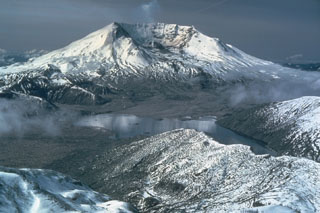Report on St. Helens (United States) — December 1989
Scientific Event Alert Network Bulletin, vol. 14, no. 12 (December 1989)
Managing Editor: Lindsay McClelland.
St. Helens (United States) Small ash emission; ashfalls to 80 km distance
Please cite this report as:
Global Volcanism Program, 1989. Report on St. Helens (United States) (McClelland, L., ed.). Scientific Event Alert Network Bulletin, 14:12. Smithsonian Institution. https://doi.org/10.5479/si.GVP.SEAN198912-321050
St. Helens
United States
46.2°N, 122.18°W; summit elev. 2549 m
All times are local (unless otherwise noted)
A brief explosive episode at 0537 on 6 January ejected ballistic tephra and a small amount of ash, and triggered rock avalanches. Strong winds carried the ash E, forming a very thin deposit along a narrow discontinuous band that extended 130 km (to the Toppenish area).
The 6 January vent was located at the apex of an arcuate fracture that climbs the dome's N flank to the vent position ~100 m above the crater floor, roughly one third of the way up the dome. The segment N of the fracture moved nearly 2 m outward and downward during the eruption. The ends of the fracture were ~400 m apart. The explosion had a northerly component, sending large ballistic tephra to the N base of the dome, where the Garden Rock seismometer was damaged. South of the vent, there were no new ballistics and only about a centimeter of fine ash had been deposited nearby. Deposition W of the dome was limited to ~1 mm of mud, and only dirty snow was found E of the dome. Rock-and-snow avalanches had originated from the fracture, leaving a scallop-shaped scar on the dome's N flank and forming two separate lobes at the base of the dome. One lobe was composed of dirty snow overlain by granular lithics. To its E, the larger avalanche lobe appeared to extend no more than 200 m from the base of the dome and contained mostly coarse rockfall material with a little snow. Some of its boulders had rolled in snow. Its maximum thickness was ~50 cm at a site roughly 100 m N of the base of the dome. The largest rock fragments beyond the base of the dome were ~30-40 cm in diameter, but 1-m boulders could be seen in the talus chute on the dome. Large ice crystals in the snow suggested that the avalanches had been warm at the time of emplacement, then had refrozen.
The 6 January tephra was dominated by lithic fragments from the dome, but dark, glassy, vesicular, dacitic material of unknown origin was also found in the ejecta. Although its mineralogy was the same as that of previous dome samples, proportions of mineral components were different, and its glass was pale brown in contrast to the clear glass that has characterized previously extruded dome rocks. The new material resembled hornblende-bearing andesites erupted by Mt. St. Helens between AD 1500 and 1800, but appeared very fresh and showed no signs of hydrothermal alteration.
Seismicity associated with the 6 January episode appeared suddenly, and saturated the station (YEL) ~1 km N of the dome for ~9 minutes (compared to 2 minutes for the [6] December seismicity). The signal was characterized by numerous minor shallow earthquakes and volcanic tremor, lasting a little more than 2.5 hours, with alternating periods of intense and low-level activity. Average tremor amplitudes were similar for the first 20 minutes of the [6] December and 6 January episodes, but the later [6] December tremor was stronger and continued for ~5 hours. Some rockfall signals occurred after both episodes. Seismicity following the 6 January episode was dominated by discrete earthquakes, with about a dozen recorded in the next few hours. After continuous tremor ended on 7 December, at least nine high-frequency, tremor-like, signals (cigar-shaped on the seismogram) lasting 2-20 minutes were recorded, accompanied by only two tiny earthquakes. Two of the cigar-shaped signals, each lasting ~2 minutes, were detected in the hours following the 6 January episode. Similar signals have been recorded during eruptions of Old Faithful Geyser at Yellowstone (Kieffer, 1984), and were thought to represent hydrothermal venting or near-surface movement of fluids at Ruiz volcano.
No pre-eruption deformation was detected, and the first sign of the activity on the tiltmeter nearest the vent was the loss of its signal. A second instrument showed a deflection of ~20 µrads during the eruptive episode. Outward movement of the dome's N flank apparently occurred during the eruption, with a maximum measured value of 1.8 m. No deformation was detected on the outer flanks of the edifice.
Reference: Kieffer, S.W., 1984, Seismicity at Old Faithful Geyser: An Isolated Source of Geothermal Noise and Possible Analogue to Volcanic Seismicity; Journal of Volcanology and Geothermal Research, v. 22, p. 59-86.
Geological Summary. Prior to 1980, Mount St. Helens was a conical volcano sometimes known as the Fujisan of America. During the 1980 eruption the upper 400 m of the summit was removed by slope failure, leaving a 2 x 3.5 km breached crater now partially filled by a lava dome. There have been nine major eruptive periods beginning about 40-50,000 years ago, and it has been the most active volcano in the Cascade Range during the Holocene. Prior to 2,200 years ago, tephra, lava domes, and pyroclastic flows were erupted, forming the older edifice, but few lava flows extended beyond the base of the volcano. The modern edifice consists of basaltic as well as andesitic and dacitic products from summit and flank vents. Eruptions in the 19th century originated from the Goat Rocks area on the N flank, and were witnessed by early settlers.
Information Contacts: D. Swanson and D. Dzurisin, CVO; C. Jonientz-Trisler, University of Washington.

